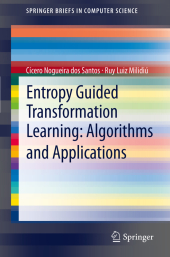 Neuerscheinungen 2012Stand: 2020-01-07 |
Schnellsuche
ISBN/Stichwort/Autor
|
Herderstraße 10
10625 Berlin
Tel.: 030 315 714 16
Fax 030 315 714 14
info@buchspektrum.de |

Ruy Luiz Milidiú, Cícero Nogueira dos Santos
(Beteiligte)
Entropy Guided Transformation Learning: Algorithms and Applications
2012. 2012. xiii, 78 S. 10 SW-Abb., 32 Tabellen. 235 mm
Verlag/Jahr: SPRINGER, BERLIN 2012
ISBN: 1-447-12977-6 (1447129776)
Neue ISBN: 978-1-447-12977-6 (9781447129776)
Preis und Lieferzeit: Bitte klicken
Entropy Guided Transformation Learning: Algorithms and Applications (ETL) presents a machine learning algorithm for classification tasks. ETL generalizes Transformation Based Learning (TBL) by solving the TBL bottleneck: the construction of good template sets. ETL automatically generates templates using Decision Tree decomposition.
The authors describe ETL Committee, an ensemble method that uses ETL as the base learner. Experimental results show that ETL Committee improves the effectiveness of ETL classifiers. The application of ETL is presented to four Natural Language Processing (NLP) tasks: part-of-speech tagging, phrase chunking, named entity recognition and semantic role labeling. Extensive experimental results demonstrate that ETL is an effective way to learn accurate transformation rules, and shows better results than TBL with handcrafted templates for the four tasks. By avoiding the use of handcrafted templates, ETL enables the use of transformation rules to a greater range of tasks.
Suitable for both advanced undergraduate and graduate courses, Entropy Guided Transformation Learning: Algorithms and Applications provides a comprehensive introduction to ETL and its NLP applications.
Preface.- Acknowledgements.- Acronyms.- Part I Entropy Guided Transformation Learning: Algorithms.- Introduction.- Entropy Guided Transformation Learning.- ETL Committee.- Part II Entropy Guided Transformation Learning: Applications.- General ETL Modeling for NLP Tasks.- Part-of-Speech Tagging.- Phrase Chunking.- Named Entity Recognition.- Semantic Role Labeling.- Conclusions.- Appendices.


